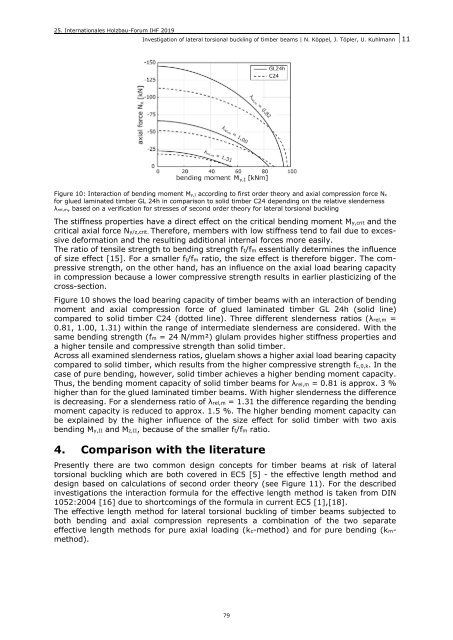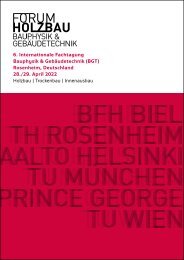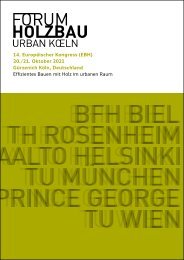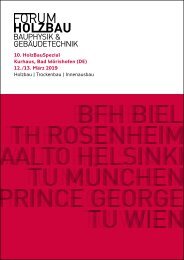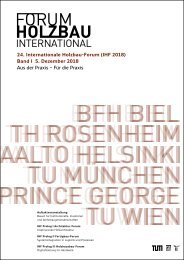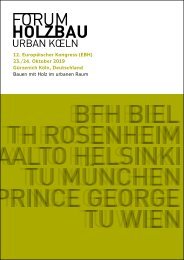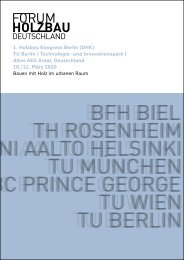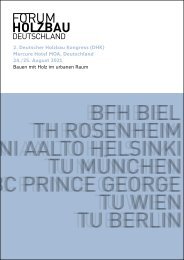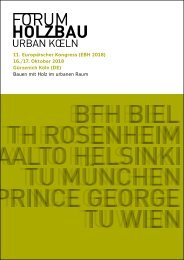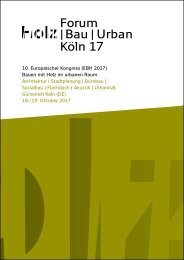25. Internationale Holzbau-Forum (IHF 2019) - Band III
Erfolgreiche ePaper selbst erstellen
Machen Sie aus Ihren PDF Publikationen ein blätterbares Flipbook mit unserer einzigartigen Google optimierten e-Paper Software.
<strong>25.</strong> <strong>Internationale</strong>s <strong>Holzbau</strong>-<strong>Forum</strong> <strong>IHF</strong> <strong>2019</strong><br />
Investigation of lateral torsional buckling of timber beams | N. Köppel, J. Töpler, U. Kuhlmann 11<br />
Figure 10: Interaction of bending moment My,I according to first order theory and axial compression force Nx<br />
for glued laminated timber GL 24h in comparison to solid timber C24 depending on the relative slenderness<br />
λrel,m, based on a verification for stresses of second order theory for lateral torsional buckling<br />
The stiffness properties have a direct effect on the critical bending moment My,crit and the<br />
critical axial force Ny/z,crit. Therefore, members with low stiffness tend to fail due to excessive<br />
deformation and the resulting additional internal forces more easily.<br />
The ratio of tensile strength to bending strength ft/fm essentially determines the influence<br />
of size effect [15]. For a smaller ft/fm ratio, the size effect is therefore bigger. The compressive<br />
strength, on the other hand, has an influence on the axial load bearing capacity<br />
in compression because a lower compressive strength results in earlier plasticizing of the<br />
cross-section.<br />
Figure 10 shows the load bearing capacity of timber beams with an interaction of bending<br />
moment and axial compression force of glued laminated timber GL 24h (solid line)<br />
compared to solid timber C24 (dotted line). Three different slenderness ratios (λrel,m =<br />
0.81, 1.00, 1.31) within the range of intermediate slenderness are considered. With the<br />
same bending strength (fm = 24 N/mm²) glulam provides higher stiffness properties and<br />
a higher tensile and compressive strength than solid timber.<br />
Across all examined slenderness ratios, gluelam shows a higher axial load bearing capacity<br />
compared to solid timber, which results from the higher compressive strength fc,0,k. In the<br />
case of pure bending, however, solid timber achieves a higher bending moment capacity.<br />
Thus, the bending moment capacity of solid timber beams for λrel,m = 0.81 is approx. 3 %<br />
higher than for the glued laminated timber beams. With higher slenderness the difference<br />
is decreasing. For a slenderness ratio of λrel,m = 1.31 the difference regarding the bending<br />
moment capacity is reduced to approx. 1.5 %. The higher bending moment capacity can<br />
be explained by the higher influence of the size effect for solid timber with two axis<br />
bending My,II and Mz,II, because of the smaller ft/fm ratio.<br />
4. Comparison with the literature<br />
Presently there are two common design concepts for timber beams at risk of lateral<br />
torsional buckling which are both covered in EC5 [5] - the effective length method and<br />
design based on calculations of second order theory (see Figure 11). For the described<br />
investigations the interaction formula for the effective length method is taken from DIN<br />
1052:2004 [16] due to shortcomings of the formula in current EC5 [1],[18].<br />
The effective length method for lateral torsional buckling of timber beams subjected to<br />
both bending and axial compression represents a combination of the two separate<br />
effective length methods for pure axial loading (kc-method) and for pure bending (kmmethod).<br />
79


